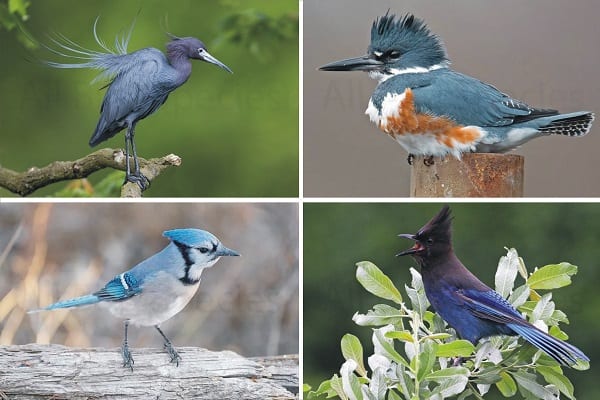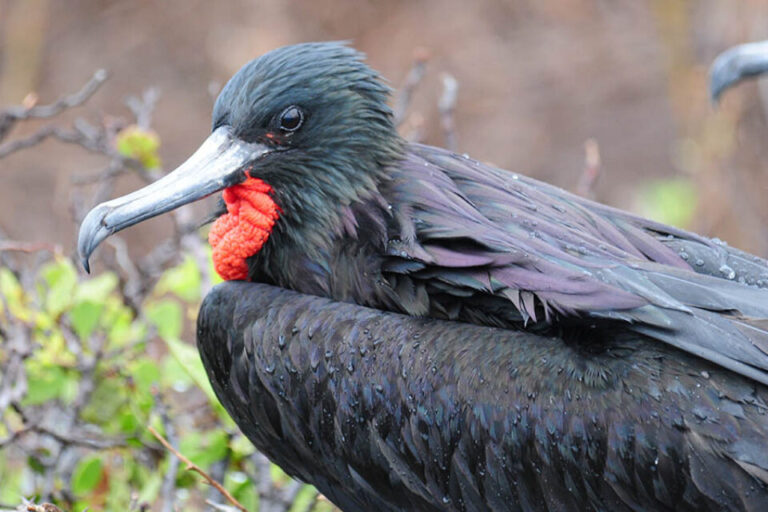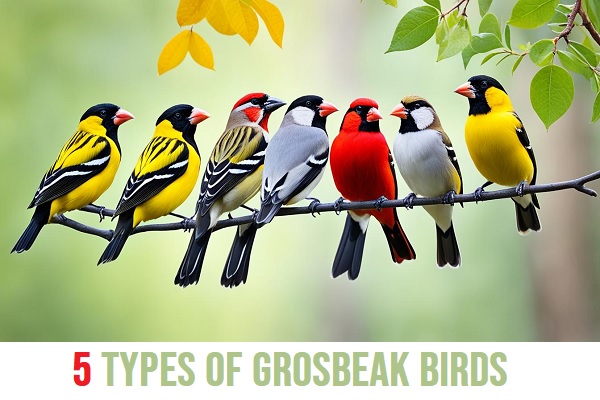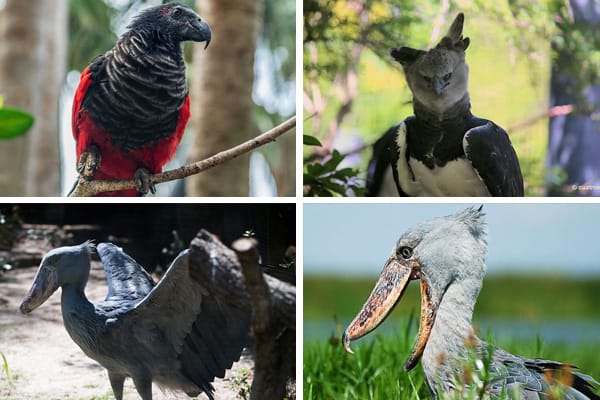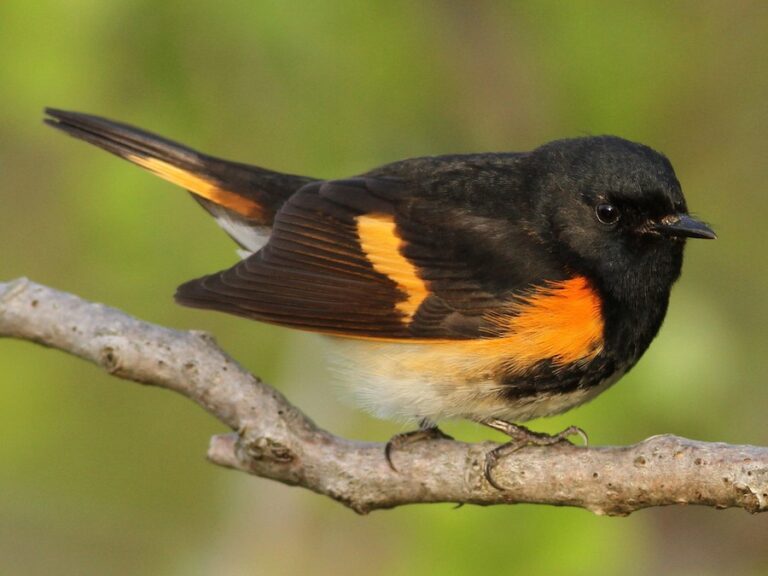16 Blue Colored Birds With Names and Images
I’ve researched the captivating world of blue colored birds. These stunning creatures are more than just visually striking; they hold rich symbolism. From the blue jay to the bluebird, each species has a unique story. Their vibrant colors often represent joy and hope. Learning about these birds can deepen our appreciation for nature. Let’s dive into their meanings and discover what makes them so special.
1. Blue Grosbeak
• Scientific name: Passerina caerulea
• Size: 5.5-7.5 inches long
• Weight: 0.8-1.1 ounces
• Lifespan: Up to 5-7 years in the wild
• Diet: Seeds, insects, and small fruits
The Blue Grosbeak is a real stunner with its deep blue feathers and silver beak. It’s like a little piece of the night sky came to life! These birds love to hang out in open areas with scattered trees and bushes.

You might spot them perched on fence posts or power lines, singing their sweet, warbling song. Male Blue Grosbeaks are the showstoppers with their bright blue color, while females are more subtle with their brown feathers. These birds are quite the travelers, spending their summers in the southern United States and winters in Central America.
2. Mountain Bluebird
• Scientific name: Sialia currucoides
• Size: 6.3-7.9 inches long
• Weight: 0.8-1.1 ounces
• Lifespan: Up to 6-10 years in the wild
• Diet: Insects, berries, and small fruits
Imagine the color of a clear summer sky, and you’ve got the Mountain Bluebird! These beautiful birds are a sight to behold with their bright, sky-blue feathers.
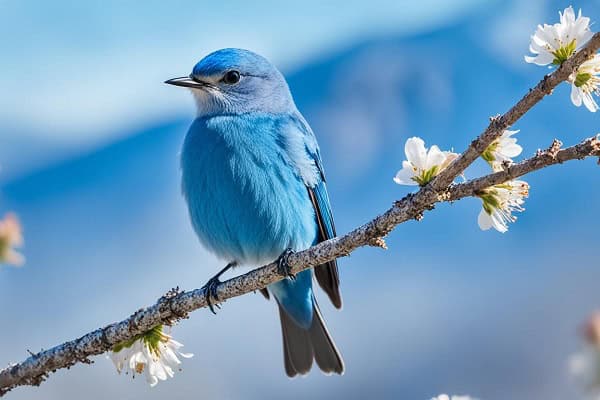
They love wide-open spaces and are often seen in meadows, prairies, and high mountain areas. Mountain Bluebirds are expert flyers and can hover in the air like tiny helicopters when hunting for insects. They’re not just pretty faces – these birds are also great parents, working together to raise their chicks in cozy nest boxes or tree cavities.
3. Bluebirds
• Scientific name: Sialia sialis (Eastern Bluebird)
• Size: 6.3-8.3 inches long
• Weight: 0.9-1.2 ounces
• Lifespan: Up to 6-10 years in the wild
• Diet: Insects, berries, and small fruits
Bluebirds are like little bundles of joy with wings! The Eastern Bluebird, in particular, is a favorite among birdwatchers. With its bright blue back, rusty orange chest, and white belly, it’s like a flying work of art.
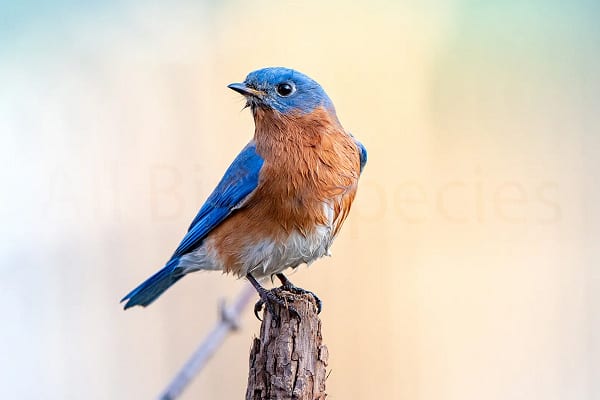
These friendly birds love open areas with short grass, where they can easily spot insects to eat. Bluebirds are known for their gentle personalities and sweet, warbling songs. Many people put up special bluebird houses to attract these charming birds to their yards.
4. Blue Jay
• Scientific name: Cyanocitta cristata
• Size: 9-12 inches long
• Weight: 2.5-3.5 ounces
• Lifespan: Up to 7 years in the wild
• Diet: Nuts, seeds, insects, and occasionally small animals
The Blue Jay is like the class clown of the bird world – noisy, colorful, and always up to something! With its bright blue feathers, black necklace, and jaunty crest, the Blue Jay is hard to miss.
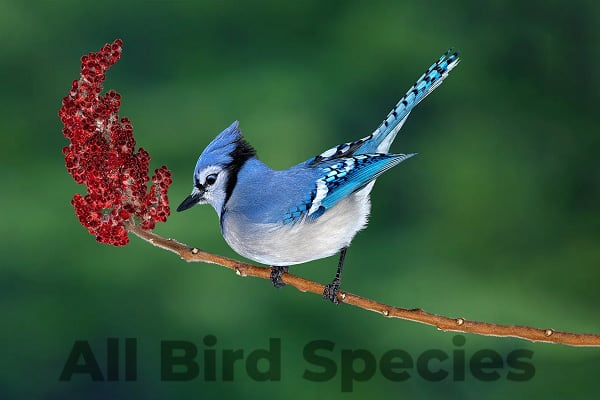
These smart birds are known for their loud, jay-jay calls and their ability to mimic the sounds of other birds and even some animals. Blue Jays are curious and bold, often the first to visit backyard feeders. They’re also quite the planters, as they bury acorns and nuts for later, sometimes forgetting them and accidentally planting new trees!
5. Tree Swallow
• Scientific name: Tachycineta bicolor
• Size: 4.7-5.9 inches long
• Weight: 0.6-0.9 ounces
• Lifespan: Up to 8 years in the wild
• Diet: Flying insects and some berries
Tree Swallows blue colored birds are like tiny acrobats of the sky! These sleek birds have iridescent blue-green backs and pure white undersides, making them look like they’re wearing tuxedos as they zip through the air.
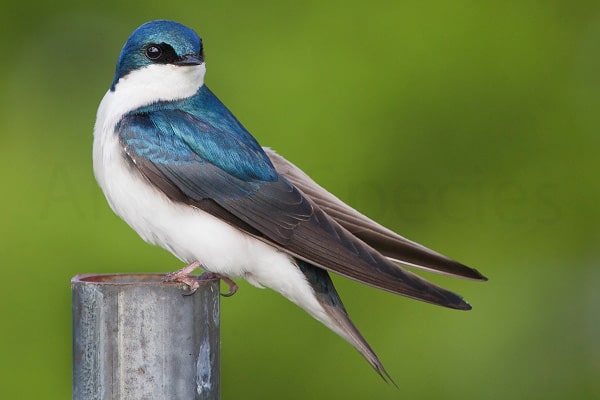
Tree Swallows are amazing flyers, catching insects on the wing with incredible speed and agility. They love open areas near water and often nest in tree cavities or birdhouses. These social birds gather in huge flocks during migration, creating spectacular aerial displays as they swoop and dive together.
6. Northern Parula
• Scientific name: Setophaga americana
• Size: 4.3-4.7 inches long
• Weight: 0.2-0.4 ounces
• Lifespan: Up to 7 years in the wild
• Diet: Insects and spiders
The Northern Parula is like a tiny rainbow with wings! This small warbler has a unique blue-gray color on its back with a yellow-green patch and two white wing bars.
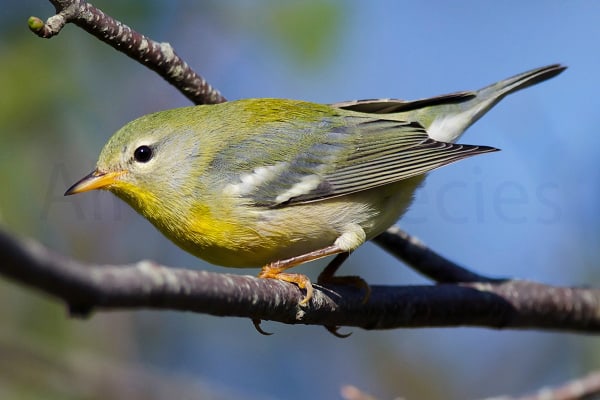
Its most distinctive feature is a bright yellow throat and chest with a dark blue-black band. Northern Parulas are forest dwellers, often found high up in the treetops where they flit about, searching for insects. Their song is a rising, buzzy trill that sounds a bit like a zipper being pulled up quickly.
7. Lazuli Bunting
• Scientific name: Passerina amoena
• Size: 5.1-5.9 inches long
• Weight: 0.5-0.6 ounces
• Lifespan: Up to 5-6 years in the wild
• Diet: Seeds, insects, and berries
The Lazuli Bunting is like a painting come to life! Male Lazuli Buntings are a stunning bright blue on top, with a rusty orange chest and white belly. They look like they’ve been colored with the most vibrant crayons in the box!
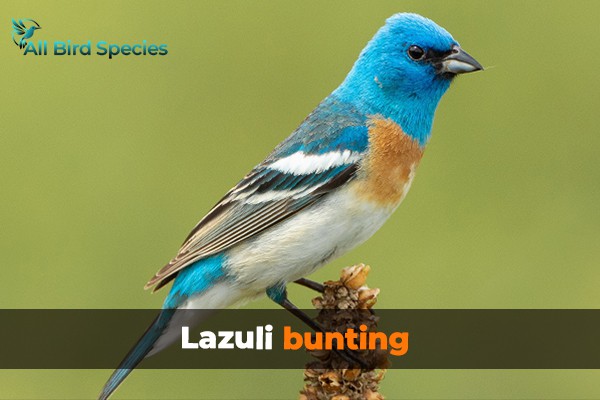
These beautiful birds are found in the western United States during the summer. They love brushy hillsides and open woodlands where they can sing their sweet, warbling songs from exposed perches. Lazuli Buntings are seed-eaters but also catch insects to feed their young.
8. Steller’s Jay
• Scientific name: Cyanocitta stelleri
• Size: 11.8-13.4 inches long
• Weight: 3.5-4.9 ounces
• Lifespan: Up to 16 years in the wild
• Diet: Nuts, seeds, insects, and small animals
Steller’s Jays are like the punk rockers of the bird world! With their dark blue bodies, black crests, and bold attitudes, these birds really stand out. They’re found in the forests of western North America and are known for their loud, harsh calls.
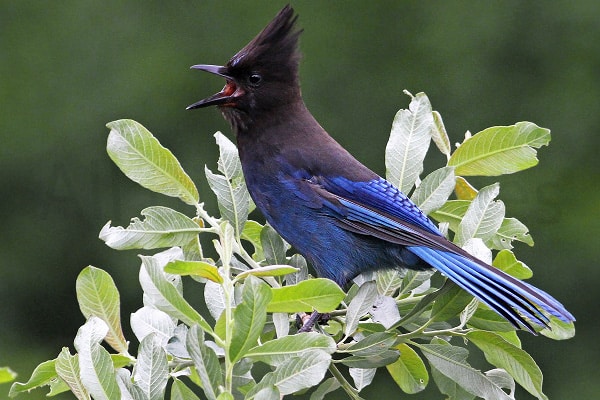
Steller’s Jays are super smart and curious, often figuring out how to open containers or steal food from picnic tables. They’re also great mimics and can copy the sounds of other birds, animals, and even human-made noises like car alarms!
9. California Scrub-Jay
• Scientific name: Aphelocoma californica
• Size: 11-12 inches long
• Weight: 2.5-3.5 ounces
• Lifespan: Up to 9 years in the wild
• Diet: Insects, nuts, seeds, and small animals
The California Scrub-Jay is like a little piece of the California sky come down to earth! These birds have bright blue and gray feathers, with a pale underside and a bold personality to match their looks.
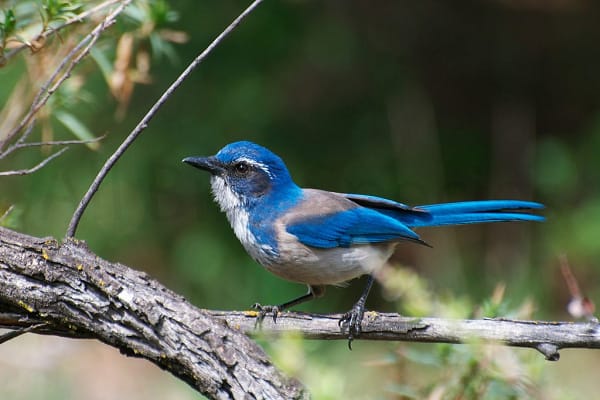
They’re found in the western United States, especially in oak woodlands and chaparral. California Scrub-Jays are known for their intelligence and their habit of storing food for later. They have an amazing memory and can remember thousands of hiding spots where they’ve buried acorns and seeds!
10. Little Blue Heron
• Scientific name: Egretta caerulea
• Size: 22-29 inches tall
• Weight: 10.5-14.1 ounces
• Lifespan: Up to 7-8 years in the wild
• Diet: Fish, frogs, and aquatic invertebrates
The Little Blue Heron is like a graceful ballerina of the wetlands! These elegant birds are a lovely slate-blue color all over, with long necks and legs.
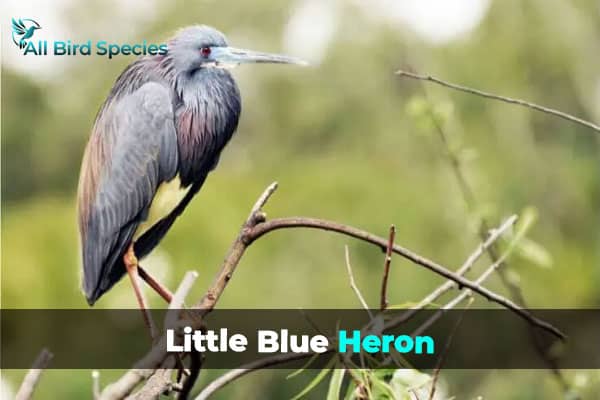
Young Little Blue Herons start out white and gradually change to blue as they grow up. These herons are found near water, in marshes, swamps, and along the edges of ponds and lakes. They’re patient hunters, often standing still for long periods or slowly stalking through shallow water to catch their prey.
11. Belted Kingfisher
• Scientific name: Megaceryle alcyon
• Size: 11-14 inches long
• Weight: 5-6 ounces
• Lifespan: Up to 6-14 years in the wild
• Diet: Fish, crayfish, and aquatic insects
The Belted Kingfisher is like a feathered fishing expert! These stocky birds have big heads with shaggy crests that make them look like they’re having a bad hair day.

They’re mostly blue-gray with white undersides and a cool blue belt across their chest. Belted Kingfishers are found near water, where they perch on branches overlooking streams, rivers, or lakes. They dive headfirst into the water to catch fish, making a big splash! Their call is a loud, rattling sound that you can often hear before you see the bird.
12. Blue-gray Gnatcatcher
• Scientific name: Polioptila caerulea
• Size: 4-5 inches long
• Weight: 0.2-0.3 ounces
• Lifespan: Up to 3-4 years in the wild
• Diet: Small insects and spiders
The Blue-gray Gnatcatcher is like a tiny, feathered acrobat! These small birds are a soft blue-gray color with white edges on their long tails.
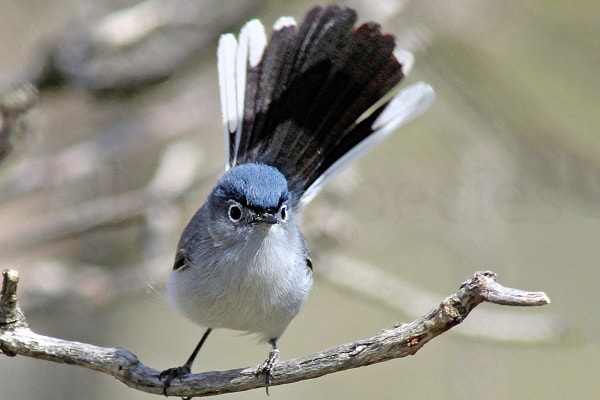
They’re always on the move, flitting from branch to branch in search of tiny insects. Blue-gray Gnatcatchers have a habit of flicking their tails as they move, which helps them stir up insects to eat. Their call is a soft, wheezy sound that some people say sounds like a squeaky toy! Despite their small size, these birds are fierce defenders of their territory and will chase away much larger birds.
13. Barn Swallow
• Scientific name: Hirundo rustica
• Size: 5.9-7.5 inches long
• Weight: 0.6-0.7 ounces
• Lifespan: Up to 4-8 years in the wild
• Diet: Flying insects
Barn Swallows are like the fighter jets of the bird world! These sleek birds have dark blue backs, rusty-colored throats and foreheads, and long, forked tails that make them easy to spot.
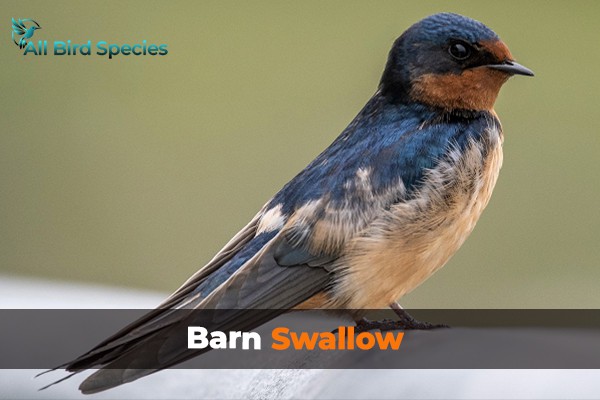
Barn Swallows are incredible flyers, zipping through the air with amazing speed and agility as they catch insects on the wing. They often build their mud nests on man-made structures like barns (hence their name), bridges, and under the eaves of houses. Barn Swallows are social birds and often fly in large groups, especially during migration.
14. Black-throated Blue Warbler
• Scientific name: Setophaga caerulescens
• Size: 4.3-5.1 inches long
• Weight: 0.3-0.4 ounces
• Lifespan: Up to 7-10 years in the wild
• Diet: Insects and spiders
The Black-throated Blue Warbler is like a dapper gentleman in a blue suit! Male Black-throated Blue Warblers are a striking deep blue on top with a black face and throat, and a crisp white belly.
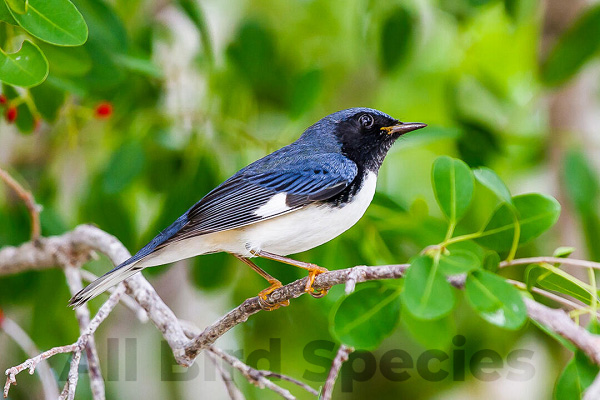
Females look completely different, with olive-green backs and yellowish undersides. These warblers spend their summers in the forests of eastern North America and winters in the Caribbean. They have a buzzy, slurred song that sounds a bit like “I’m so laz-eeee.”
15. Cerulean Warbler
• Scientific name: Setophaga cerulea
• Size: 4.3-4.7 inches long
• Weight: 0.3-0.4 ounces
• Lifespan: Up to 6-7 years in the wild
• Diet: Insects and spiders
The Cerulean Warbler is like a little piece of the sky come to life! These small warblers are a beautiful sky-blue color with darker blue streaks on their backs and two white wing bars. Cerulean Warblers are found in the treetops of deciduous forests in eastern North America during the summer.
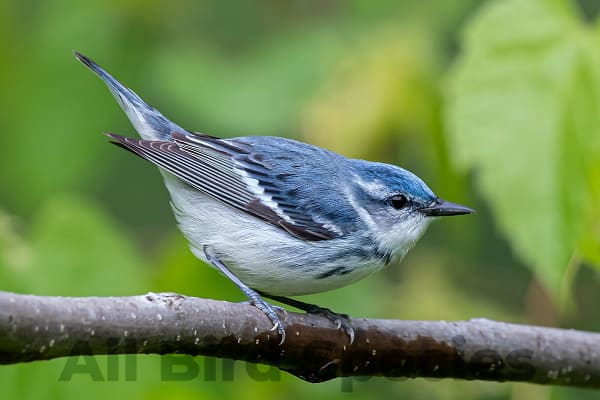
They’re known for their love of high places and are often seen at the very tops of tall trees. Sadly, Cerulean Warblers are becoming rare due to loss of their forest homes. Their song is a series of buzzy notes that rise at the end, like they’re asking a question.
These blue-colored birds are just a small sample of the amazing diversity of feathered friends that share our world. From the tiny Blue-gray Gnatcatcher to the elegant Great Blue Heron, each species has its own unique characteristics, behaviors, and beauty. By learning about these birds, we can better appreciate the natural world around us and understand the importance of protecting their habitats. So next time you’re outside, keep your eyes peeled for a flash of blue – you might just spot one of these incredible blue-colored birds!
Read More🐦Related Articles:
- Swallow Spiritual meaning
- Hummingbirds in Maryland
- Spiritual Meaning Of Ducks
- Can Birds Eat Popcorn
- Woodpecker Spiritual Meaning
- What is Hobbes Bird?
Frequently Asked Questions:
Q1. Which birds are blue colored?
Many birds have blue coloring, including the blue jay, bluebird, and indigo bunting.
Q2. What is the name of the big blue bird?
The great blue heron is a well-known large blue bird.
Q3. Are blue Colored Birds rare?
Some blue birds, like the Eastern bluebird, are common, while others, like the blue grosbeak, can be less frequently spotted.
Q4. Which is blue bird?
Common examples of blue birds include the blue jay, eastern bluebird, and indigo bunting.

